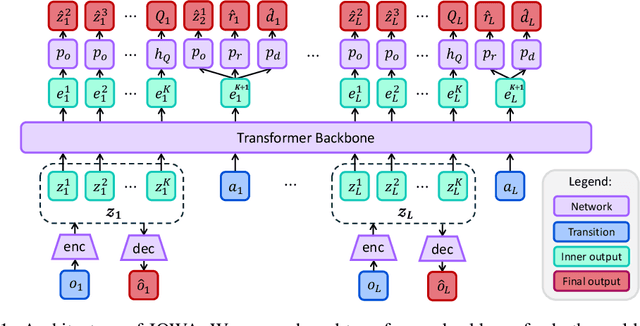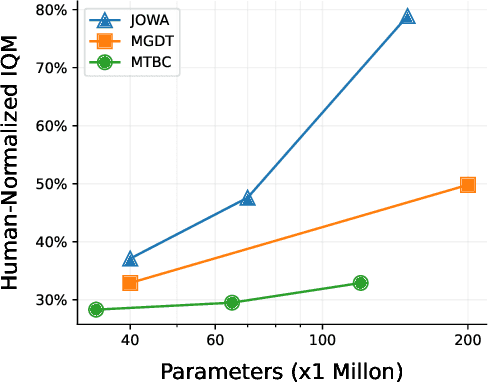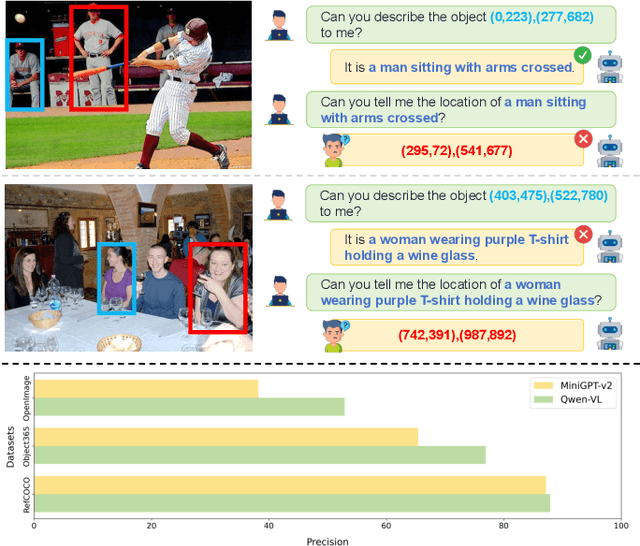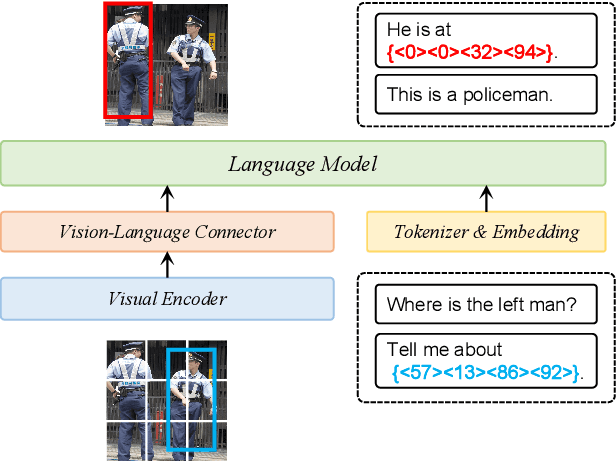Gang Xiong
Missing Target-Relevant Information Prediction with World Model for Accurate Zero-Shot Composed Image Retrieval
Mar 21, 2025Abstract:Zero-Shot Composed Image Retrieval (ZS-CIR) involves diverse tasks with a broad range of visual content manipulation intent across domain, scene, object, and attribute. The key challenge for ZS-CIR tasks is to modify a reference image according to manipulation text to accurately retrieve a target image, especially when the reference image is missing essential target content. In this paper, we propose a novel prediction-based mapping network, named PrediCIR, to adaptively predict the missing target visual content in reference images in the latent space before mapping for accurate ZS-CIR. Specifically, a world view generation module first constructs a source view by omitting certain visual content of a target view, coupled with an action that includes the manipulation intent derived from existing image-caption pairs. Then, a target content prediction module trains a world model as a predictor to adaptively predict the missing visual information guided by user intention in manipulating text at the latent space. The two modules map an image with the predicted relevant information to a pseudo-word token without extra supervision. Our model shows strong generalization ability on six ZS-CIR tasks. It obtains consistent and significant performance boosts ranging from 1.73% to 4.45% over the best methods and achieves new state-of-the-art results on ZS-CIR. Our code is available at https://github.com/Pter61/predicir.
MADS: Multi-Attribute Document Supervision for Zero-Shot Image Classification
Mar 10, 2025Abstract:Zero-shot learning (ZSL) aims to train a model on seen classes and recognize unseen classes by knowledge transfer through shared auxiliary information. Recent studies reveal that documents from encyclopedias provide helpful auxiliary information. However, existing methods align noisy documents, entangled in visual and non-visual descriptions, with image regions, yet solely depend on implicit learning. These models fail to filter non-visual noise reliably and incorrectly align non-visual words to image regions, which is harmful to knowledge transfer. In this work, we propose a novel multi-attribute document supervision framework to remove noises at both document collection and model learning stages. With the help of large language models, we introduce a novel prompt algorithm that automatically removes non-visual descriptions and enriches less-described documents in multiple attribute views. Our proposed model, MADS, extracts multi-view transferable knowledge with information decoupling and semantic interactions for semantic alignment at local and global levels. Besides, we introduce a model-agnostic focus loss to explicitly enhance attention to visually discriminative information during training, also improving existing methods without additional parameters. With comparable computation costs, MADS consistently outperforms the SOTA by 7.2% and 8.2% on average in three benchmarks for document-based ZSL and GZSL settings, respectively. Moreover, we qualitatively offer interpretable predictions from multiple attribute views.
ProAPO: Progressively Automatic Prompt Optimization for Visual Classification
Feb 27, 2025Abstract:Vision-language models (VLMs) have made significant progress in image classification by training with large-scale paired image-text data. Their performances largely depend on the prompt quality. While recent methods show that visual descriptions generated by large language models (LLMs) enhance the generalization of VLMs, class-specific prompts may be inaccurate or lack discrimination due to the hallucination in LLMs. In this paper, we aim to find visually discriminative prompts for fine-grained categories with minimal supervision and no human-in-the-loop. An evolution-based algorithm is proposed to progressively optimize language prompts from task-specific templates to class-specific descriptions. Unlike optimizing templates, the search space shows an explosion in class-specific candidate prompts. This increases prompt generation costs, iterative times, and the overfitting problem. To this end, we first introduce several simple yet effective edit-based and evolution-based operations to generate diverse candidate prompts by one-time query of LLMs. Then, two sampling strategies are proposed to find a better initial search point and reduce traversed categories, saving iteration costs. Moreover, we apply a novel fitness score with entropy constraints to mitigate overfitting. In a challenging one-shot image classification setting, our method outperforms existing textual prompt-based methods and improves LLM-generated description methods across 13 datasets. Meanwhile, we demonstrate that our optimal prompts improve adapter-based methods and transfer effectively across different backbones.
Reason-before-Retrieve: One-Stage Reflective Chain-of-Thoughts for Training-Free Zero-Shot Composed Image Retrieval
Dec 15, 2024Abstract:Composed Image Retrieval (CIR) aims to retrieve target images that closely resemble a reference image while integrating user-specified textual modifications, thereby capturing user intent more precisely. Existing training-free zero-shot CIR (ZS-CIR) methods often employ a two-stage process: they first generate a caption for the reference image and then use Large Language Models for reasoning to obtain a target description. However, these methods suffer from missing critical visual details and limited reasoning capabilities, leading to suboptimal retrieval performance. To address these challenges, we propose a novel, training-free one-stage method, One-Stage Reflective Chain-of-Thought Reasoning for ZS-CIR (OSrCIR), which employs Multimodal Large Language Models to retain essential visual information in a single-stage reasoning process, eliminating the information loss seen in two-stage methods. Our Reflective Chain-of-Thought framework further improves interpretative accuracy by aligning manipulation intent with contextual cues from reference images. OSrCIR achieves performance gains of 1.80% to 6.44% over existing training-free methods across multiple tasks, setting new state-of-the-art results in ZS-CIR and enhancing its utility in vision-language applications. Our code will be available at https://github.com/Pter61/osrcir2024/.
Denoise-I2W: Mapping Images to Denoising Words for Accurate Zero-Shot Composed Image Retrieval
Oct 22, 2024



Abstract:Zero-Shot Composed Image Retrieval (ZS-CIR) supports diverse tasks with a broad range of visual content manipulation intentions that can be related to domain, scene, object, and attribute. A key challenge for ZS-CIR is to accurately map image representation to a pseudo-word token that captures the manipulation intention relevant image information for generalized CIR. However, existing methods between the retrieval and pre-training stages lead to significant redundancy in the pseudo-word tokens. In this paper, we propose a novel denoising image-to-word mapping approach, named Denoise-I2W, for mapping images into denoising pseudo-word tokens that, without intention-irrelevant visual information, enhance accurate ZS-CIR. Specifically, a pseudo triplet construction module first automatically constructs pseudo triples (\textit{i.e.,} a pseudo-reference image, a pseudo-manipulation text, and a target image) for pre-training the denoising mapping network. Then, a pseudo-composed mapping module maps the pseudo-reference image to a pseudo-word token and combines it with the pseudo-manipulation text with manipulation intention. This combination aligns with the target image, facilitating denoising intention-irrelevant visual information for mapping. Our proposed Denoise-I2W is a model-agnostic and annotation-free approach. It demonstrates strong generalization capabilities across three state-of-the-art ZS-CIR models on four benchmark datasets. By integrating Denoise-I2W with existing best models, we obtain consistent and significant performance boosts ranging from 1.45\% to 4.17\% over the best methods without increasing inference costs. and achieve new state-of-the-art results on ZS-CIR. Our code is available at \url{https://github.com/Pter61/denoise-i2w-tmm}.
Scaling Offline Model-Based RL via Jointly-Optimized World-Action Model Pretraining
Oct 01, 2024



Abstract:A significant aspiration of offline reinforcement learning (RL) is to develop a generalist agent with high capabilities from large and heterogeneous datasets. However, prior approaches that scale offline RL either rely heavily on expert trajectories or struggle to generalize to diverse unseen tasks. Inspired by the excellent generalization of world model in conditional video generation, we explore the potential of image observation-based world model for scaling offline RL and enhancing generalization on novel tasks. In this paper, we introduce JOWA: Jointly-Optimized World-Action model, an offline model-based RL agent pretrained on multiple Atari games to learn general-purpose representation and decision-making ability. Our method jointly optimizes a world-action model through shared transformer backbone, which stabilize temporal difference learning with large models during pretraining. Moreover, we propose an provably efficient and parallelizable planning algorithm to compensate for the Q-value estimation error and thus search out better policies. Experimental results indicate that our largest agent, with 150 million parameters, achieves 78.9% human-level performance on pretrained games using only 10% subsampled offline data, outperforming existing state-of-the-art large-scale offline RL baselines by 31.6% on averange. Furthermore, JOWA scales favorably with model capacity and can sample-efficiently transfer to novel games using only 5k offline fine-tuning data corresponding to about 4 trajectories per game, which demonstrates superior generalization of JOWA. We will release codes at https://github.com/CJReinforce/JOWA.
T2VIndexer: A Generative Video Indexer for Efficient Text-Video Retrieval
Aug 21, 2024



Abstract:Current text-video retrieval methods mainly rely on cross-modal matching between queries and videos to calculate their similarity scores, which are then sorted to obtain retrieval results. This method considers the matching between each candidate video and the query, but it incurs a significant time cost and will increase notably with the increase of candidates. Generative models are common in natural language processing and computer vision, and have been successfully applied in document retrieval, but their application in multimodal retrieval remains unexplored. To enhance retrieval efficiency, in this paper, we introduce a model-based video indexer named T2VIndexer, which is a sequence-to-sequence generative model directly generating video identifiers and retrieving candidate videos with constant time complexity. T2VIndexer aims to reduce retrieval time while maintaining high accuracy. To achieve this goal, we propose video identifier encoding and query-identifier augmentation approaches to represent videos as short sequences while preserving their semantic information. Our method consistently enhances the retrieval efficiency of current state-of-the-art models on four standard datasets. It enables baselines with only 30\%-50\% of the original retrieval time to achieve better retrieval performance on MSR-VTT (+1.0%), MSVD (+1.8%), ActivityNet (+1.5%), and DiDeMo (+0.2%). The code is available at https://github.com/Lilidamowang/T2VIndexer-generativeSearch.
IIU: Independent Inference Units for Knowledge-based Visual Question Answering
Aug 15, 2024Abstract:Knowledge-based visual question answering requires external knowledge beyond visible content to answer the question correctly. One limitation of existing methods is that they focus more on modeling the inter-modal and intra-modal correlations, which entangles complex multimodal clues by implicit embeddings and lacks interpretability and generalization ability. The key challenge to solve the above problem is to separate the information and process it separately at the functional level. By reusing each processing unit, the generalization ability of the model to deal with different data can be increased. In this paper, we propose Independent Inference Units (IIU) for fine-grained multi-modal reasoning to decompose intra-modal information by the functionally independent units. Specifically, IIU processes each semantic-specific intra-modal clue by an independent inference unit, which also collects complementary information by communication from different units. To further reduce the impact of redundant information, we propose a memory update module to maintain semantic-relevant memory along with the reasoning process gradually. In comparison with existing non-pretrained multi-modal reasoning models on standard datasets, our model achieves a new state-of-the-art, enhancing performance by 3%, and surpassing basic pretrained multi-modal models. The experimental results show that our IIU model is effective in disentangling intra-modal clues as well as reasoning units to provide explainable reasoning evidence. Our code is available at https://github.com/Lilidamowang/IIU.
Visual-Semantic Decomposition and Partial Alignment for Document-based Zero-Shot Learning
Jul 23, 2024Abstract:Recent work shows that documents from encyclopedias serve as helpful auxiliary information for zero-shot learning. Existing methods align the entire semantics of a document with corresponding images to transfer knowledge. However, they disregard that semantic information is not equivalent between them, resulting in a suboptimal alignment. In this work, we propose a novel network to extract multi-view semantic concepts from documents and images and align the matching rather than entire concepts. Specifically, we propose a semantic decomposition module to generate multi-view semantic embeddings from visual and textual sides, providing the basic concepts for partial alignment. To alleviate the issue of information redundancy among embeddings, we propose the local-to-semantic variance loss to capture distinct local details and multiple semantic diversity loss to enforce orthogonality among embeddings. Subsequently, two losses are introduced to partially align visual-semantic embedding pairs according to their semantic relevance at the view and word-to-patch levels. Consequently, we consistently outperform state-of-the-art methods under two document sources in three standard benchmarks for document-based zero-shot learning. Qualitatively, we show that our model learns the interpretable partial association.
SC-Tune: Unleashing Self-Consistent Referential Comprehension in Large Vision Language Models
Mar 20, 2024



Abstract:Recent trends in Large Vision Language Models (LVLMs) research have been increasingly focusing on advancing beyond general image understanding towards more nuanced, object-level referential comprehension. In this paper, we present and delve into the self-consistency capability of LVLMs, a crucial aspect that reflects the models' ability to both generate informative captions for specific objects and subsequently utilize these captions to accurately re-identify the objects in a closed-loop process. This capability significantly mirrors the precision and reliability of fine-grained visual-language understanding. Our findings reveal that the self-consistency level of existing LVLMs falls short of expectations, posing limitations on their practical applicability and potential. To address this gap, we introduce a novel fine-tuning paradigm named Self-Consistency Tuning (SC-Tune). It features the synergistic learning of a cyclic describer-locator system. This paradigm is not only data-efficient but also exhibits generalizability across multiple LVLMs. Through extensive experiments, we demonstrate that SC-Tune significantly elevates performance across a spectrum of object-level vision-language benchmarks and maintains competitive or improved performance on image-level vision-language benchmarks. Both our model and code will be publicly available at https://github.com/ivattyue/SC-Tune.
 Add to Chrome
Add to Chrome Add to Firefox
Add to Firefox Add to Edge
Add to Edge